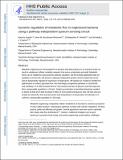Dynamic regulation of metabolic flux in engineered bacteria using a pathway-independent quorum-sensing circuit
Author(s)
Gupta, Apoorv; Brockman Reizman, Irene M.; Reisch, Christopher R.; Prather, Kristala L
DownloadAccepted version (726.0Kb)
Terms of use
Metadata
Show full item recordAbstract
Metabolic engineering of microorganisms to produce desirable products on an industrial scale can result in unbalanced cellular metabolic networks that reduce productivity and yield. Metabolic fluxes can be rebalanced using dynamic pathway regulation, but few broadly applicable tools are available to achieve this. We present a pathway-independent genetic control module that can be used to dynamically regulate the expression of target genes. We apply our module to identify the optimal point to redirect glycolytic flux into heterologous engineered pathways in Escherichia coli, resulting in titers of myo-inositol increased 5.5-fold and titers of glucaric acid increased from unmeasurable to >0.8 g/L, compared to the parent strains lacking dynamic flux control. Scaled-up production of these strains in benchtop bioreactors resulted in almost ten-and fivefold increases in specific titers of myo-inositol and glucaric acid, respectively. We also used our module to control flux into aromatic amino acid biosynthesis to increase titers of shikimate in E. coli from unmeasurable to >100 mg/L. ©2017 Nature America, Inc., part of Springer Nature.
Date issued
2017-02Department
Massachusetts Institute of Technology. Department of Biological Engineering; Massachusetts Institute of Technology. Department of Chemical Engineering; Massachusetts Institute of Technology. Synthetic Biology CenterJournal
Nature Biotechnology
Publisher
Springer Nature America, Inc
Citation
Gupta, Apoorv et al., "Dynamic regulation of metabolic flux in engineered bacteria using a pathway-independent quorum-sensing circuit." Nature Biotechnology 35, 3 (March 2017): p. 273–279 doi. 10.1038/nbt.3796 ©2017 Authors
Version: Author's final manuscript
ISSN
1546-1696